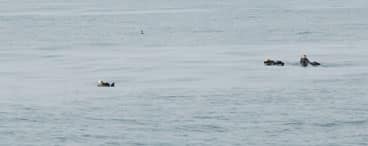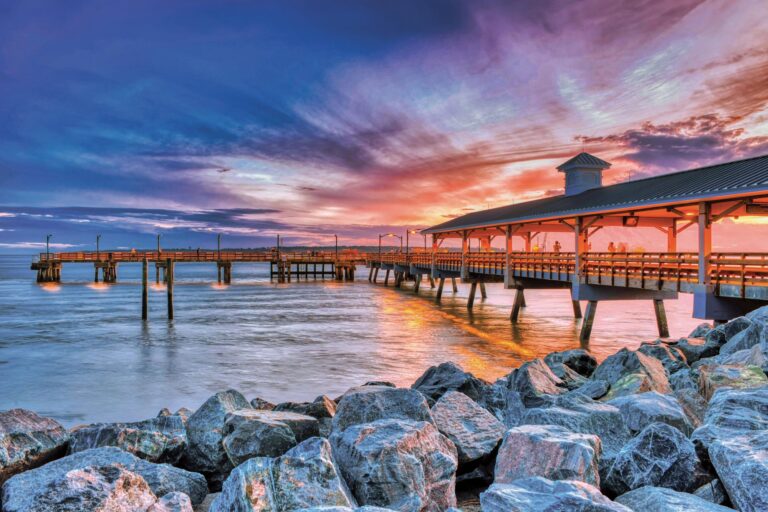
sea otters
We always plan to cross Queen Charlotte Sound as early in the day as possible. At our 6½-knot speed, it generally takes us six hours to cross from the central coast of British Columbia to the north coast. Crossing Queen Charlotte Sound, you leave the protection of Vancouver Island and are exposed to the swells and weather of the Pacific Ocean before tucking back into the calm waters behind Calvert Island. We leave early to avoid the wind and waves that build throughout the day.
The forecast was calm in the morning, then building to a northwesterly 10 to 15 knots in the afternoon, with a low northwesterly swell of about 3 feet. Jeffrey chose to take Richards Pass, and we soon were past the protection of the Storm Islands. Since the weather was nice and I was between breakfast and lunch duties, I went out on deck with my binoculars and set up a deck chair. I was hoping to find a humpback whale feeding near one of the small rocky islands that litter this part of the coast. The sky was low and turned foggy as we entered Queen Charlotte Sound. There was a faint swell. Over the VHF we could hear the chatter of tugboat captains making the decision to “run the outside” — meaning they’d go outside of Calvert Island, indicating to us that the Pacific was indeed pacific.
I scanned the horizon and strained to see the outline of the rocky islands in hopes of seeing the familiar arching crescent of a hungry humpback whale. A few seabirds dotted the gray seascape. I almost fell asleep in my chair watching. Every so often the fog would lift and the sun would shine brightly. As I looked around, I noticed a smallish 5-foot log floating on the surface. It had the familiar shape of a sea otter. I didn’t really expect anything more than a log since I’d never seen a sea otter in Queen Charlotte Sound. I knew they were once abundant in the area, but they had been so extensively hunted that none remained in modern times. I checked the log just in case. I first looked at the larger, rounder end of the log to see if I could make out a face. It was distant, and even though the fog was mostly lifted, I was pretty sure I could make out what looked to be the face of an otter. The eyes, nose and mouth seemed right. As I scanned the log I checked out the next lump, which had the right shape and proportions to be the otter’s fore-flippers. The body was low and the end was curved up. I stared at it a long time before getting up to tell Jeffrey what I had just found.
“Sea otter,” I said, stepping through the pilothouse door.
“Really? Where?” Jeffrey said.
“See that log over there?”
“Yeah.”
“Well, that’s an otter,” I said smugly.
Jeffrey picked up the binoculars. As he looked, he teased me about the time when he was running a whale-watch boat out of Seward, Alaska, and I was on the bridge with him helping to find wildlife. I’d been doing a fine job until just outside of the harbor on the return, when I spotted an otter. Jeffrey turned the boat to show the 149 passengers the otter. Then a call came up from the galley on the intercom. The crew members wanted to know if the log we were heading toward was his “otter.” It was. Jeffrey had to sheepishly admit over the public address system that what he had spotted was actually just a log.
“You’re right this time. It is an otter,” he said, and we began pointing it out to our guests. They enjoyed the sight. We both explained that seeing sea otters in Queen Charlotte Sound was a first for us.
We left the sea otters and the protection of Vancouver Island. There was a bit of swell, but it was low and comfortable — the kind of motion that can lull you to sleep. The sun came out, and soon we were abeam Cape Caution. We changed course to make our way up Fitz Hugh Sound.
When we reached Calvert Island, we spotted our first humpback whale of the year. I saw it blow. We pointed it out to our guests, and I fumbled for my camera. I was hoping to get a good picture, but as soon as I got out the door, I heard everyone ohh-ing about the whale’s fluke going down. It was going to be a while before the whale resurfaced.
We waited, and we joked about how nice it was to watch humpbacks because while they were underwater, we all had time to delete the bad pictures before it came back. Then Jeffrey spotted the whale again. It had moved farther away in the wrong direction for us. We watched it grow distant and dive. When it did, we continued on. We spent the night in Sea Otter Cove, a fitting anchorage for the day.









